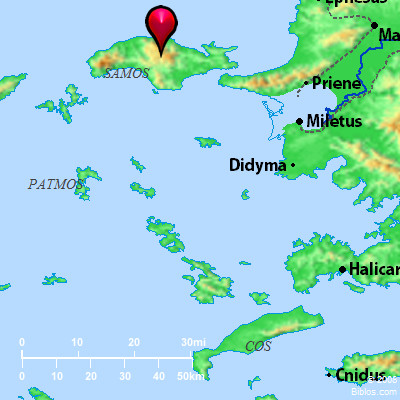Encyclopedia
SAMOSsa'-mos (Samos, "height," "mountain" (see Strabo 346, 457)): One of the most famous of the Ionian islands, third in size among the group which includes Lesbos, CHIOS (which see) and Cos (which see). It is situated at the mouth of the bay of Ephesus, between the cities of EPHESUS and MILETUS (which see), and separated from the mainland of Ionia by the narrow strait where the Greeks met and conquered the Persian fleet in the battle of Mycale, 479 B.C. (Herodotus ix.100;). The surface of the island is very rugged and mountainous, Mt. Kerki (modern name) rising to a height of 4,700 ft., and it was due to this that the island received its name (see above).
See also SAMOTHRACE.
Samos was renowned in antiquity as one of the noted centers of Ionjan luxury, and reached its zenith of prosperity under the rule of the famous tyrant Polycrates (533-522 B.C.), who made himself master of the Aegean Sea. He carried on trade with Egypt, and his intercourse with that country, his friendship with Amasis, the famous "ring" story and the revolting manner of the death of Polycrates arere all told in one of the most interesting stories of Herodotus (Herod. iii.39;).
In 84 B.C., the island was joined to the province of Asia, and in 17 B.C. it became a civitas libera, through the favor of Augustus (Dio Cass. liv0.9; Pliny, NH, v.37). Both Marcus Agrippa and Herod visited the island; and according to Josephus (Ant., XVI, ii, 2; BJ, I, xxi, 11) "bestowed a great many benefits" on it. In the Apocrypha, Samos is mentioned among the places to which Lucius, consul of the Romans, wrote, asking their good will toward the Jews (1 Maccabees 15:23).
In the New Testament, Paul touched here, after passing CHIOS (which see), on his return from his third missionary journey (Acts 20:15). In Textus Receptus of the New Testament, we find in this passage kai meinantes en Trogullio ("and having remained in Trogyllium"). This reading is wanting in the oldest manuscripts, and may be a sort of gloss, or explanation; due to the technical use of paraballein, "to touch land" (compare Josephus, Ant, XVIII, vi, 4), and not necessarily "to make a landing." Trogyllium lay on the mainland opposite Samos, at the end of the ridge of Mycale. Still there is no particular reason why this reading should be supported, especially as it is not found in the earliest of authorities. Soden's 1913 text, however, retains the reading in brackets.
LITERATURE.
Tozer, Islands of the Aegean (1890). Herodotus and Pausanias have rather full accounts of Samos, and Encyclopedia Brit (11th edition) gives a good bibliography of works both ancient and modern.
Arthur J. Kinsella
SAMOS, an island in the AEgean Sea, 27 ms. long, 10 ms. wide, about 1 1/2 ms. from the coast of Lydia. The ancient capital, Samos, was on the s. coast of the island. The pop. is 36,000 (1880). It is 3 ms. from the coast.
Strong's Greek
G4544: SamosSamos, an island in the Aegean




